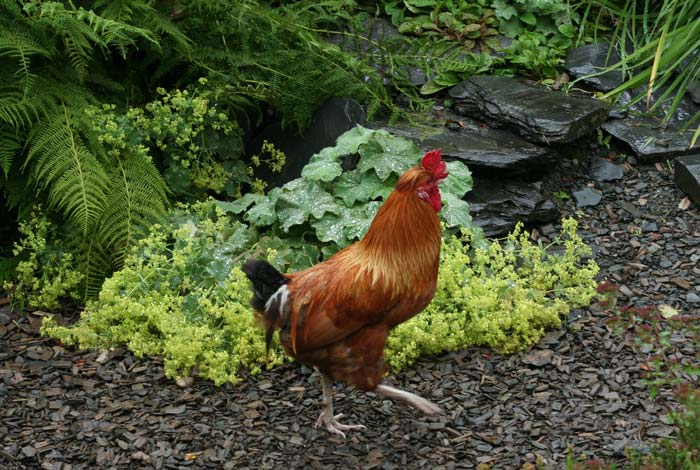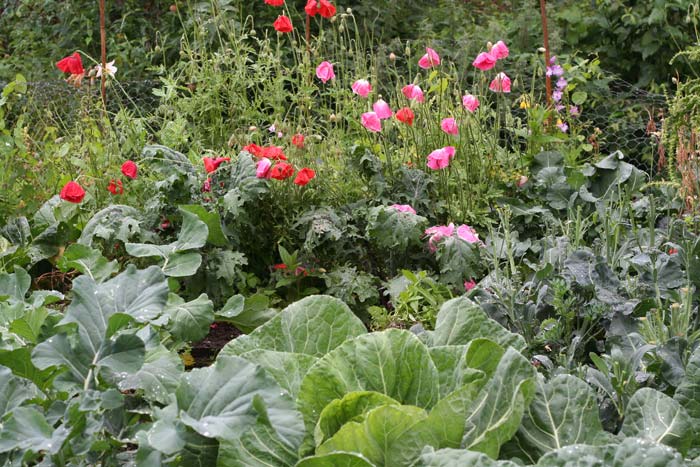Where should we look to find a welcome future direction for the art of garden design? Chelsea? Kyoto? California? Australia? Saudi Arabia? Wales? A candidate list is, please don’t laugh, in Wales. It was made by the Centre for Alternative Technology CAT.
They are muddled in some respects, including the design of a Japanese-ey Bridge, but they are surely right about three things:
- they place a great emphasis on the use of local materials. In a famous slate-quarrying region, slate is used in the CAT garden as a building material and as a paving material. This is a welcome contribution to the Great Cause of context-sensitive garden design. If gardens are made with standard ‘garden centre’ products they will not have local character
- CATare experimenting with the re-combination of food plants with beautiful plants in gardens. This is how gardens always used to be made. The idea of having separate ‘aesthetic’ and ‘vegetable’ zones in garden began with the renaissance
- CAT also have chickens at loose in the garden. They are ornamental and they lay better eggs than anything ever sold in a supermarket.
I would like to see CAT take these principles to the Chelsea Flower Show – and employ a really talented designer to explore and publicize them.



L Umbrade Garden in Valencia is not quite garden, not quite architecture & probably not quite sustainable in the usual sense. Perhaps I am wondering if the future still looks like the future, but feels like the past and is designed in the present?
Hello Tom – great posting. I quite agree that the arena of show gardens need to be shaken up to take into account the myriad of issues we are now facing. The amount of money spent especially on large show gardens is staggering, completely unfeasible for the general public and can be massively unsustainable. This has to change.
We are a small design studio committed to producing innovative and sustainable interior and exterior spaces, and this year we began our show garden career with ‘The Garden on Three R’s’ a fully edible small garden (veggies, herbs, flowers and trees) with recycled, reclaimed and remodelled items, including a reconstructed shed with green roof, beehive, wormery, solar powered water feature and recycled glass paving.
The response we had to the garden was fantastic – and we won the ‘NS&I Peoples Vote 2008’, proving that people want to be responsible, and value sustainable design. It is now up to us as designers to ensure that we use our positions to the advantage, not disadvantage of the world.
I´m not sure, chickens at loose in the garden, probably the CAT have never seen this in real. Chickens at loose in garden mean no any other plants there, just bald surface. Cock as ornamental subject in plant garden? Only ceramic (plastic) one.
Raised beds seem to become ever-more popular among vegetable growers. It the medieval period wattles were used to raise the soil, so that it warmed up, and also to protect vegetables from pigs and chickens – I assume. Wattles could probably protect plants from chickens, if they were 600mm high and the chickens wings were clipped, and they could be an attractive design feature. Chickens can still be seen in orchards in the south of Italy. They sleep in trees.
I agree with that the pictures show the future direction landscape design. I assume landscape will be practical, beautiful, self-maintaining and thus sustainable. There are still lots of facts about living (everyday life) landscape in primitive village in Yunnan, China, where people are working and going recreation by the use of nature and a man-made garden is not necessary.
The mix of objectives Xiaomin describes was traditional in Europe and in Ming Dynasty China (as Craig Clunas argues in Fruitful Sites: Garden Culture in Ming Dynasty China, 1996). It was the wealth of Qing China and post-renaissance Europe which made gardens ‘primarily aesthetic’ and the new quest for sustainability may return garden design to its historic objectives. I hope so. There is a lot of gloom in the press these days about a return to austerity but in many respects it could be a Good Thing.
There is a fine database in the plants for a future that it would be good to see more of. http://www.pfaf.org
With the popularity of the “eat the view project” a campaign to urge the Obamas to replant a large organic Victory Garden on the First Lawn at the white house, it seems to me that the current trend is towards to having a garden that will have both editable and ornamental plants.
It may take a global recession for people to rediscover vital truths. Garden design needs to refind its bearings. Function + Pleasure + Responsible = Sustainable. That was always the way in the west until the western european revolutions. I think that what they did was skew the concept of status. Before, status was about good management. After, status became about bling. We have lost touch until now. We need to challenge our clients. They don’t know how to move on. Designers need to pioneer the engineering side of this – the waste management. the water management, the ethical procurement, the awkward stuff. This is how it moves on.